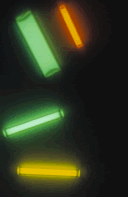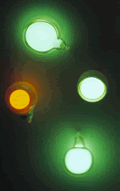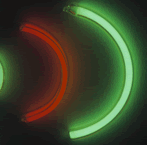G.T.L.S - AN INTRODUCTION
GTLS (Gaseous Tritium Light Source) devices are used all around us, to illuminate dials and panels, mark exits and emergency escape routes, and otherwise give visual aid or comfort in dark or night conditions. The light sources are contained in miniature sealed glass tubes of various shapes and sizes.
The tubes are made of borosilicate glass, which is tougher than ordinary glass.
The tubes are internally coated with a phosphur and filled with gaseous tritium (chemical symbol H3), a "heavy" form of hydrogen.
Tritium emits low energy electrons which excite the phosphur to give off "cold" continuous light.
The resulting low-level light emission is comparable to moonlight.
 |
 |
 |
|||||||||
|
|
 |
||||||||||
|
|
|
||||||||||
|
|
 |
|
|||||||||
|
|
|
||||||||||
|
|
 |
 |
|||||||||
 |
|
||||||||||
|
|
|
|
|||||||||
 |
|
|
|||||||||
 |
|
||||||||||
 |
|
||||||||||
 |
|||||||||||
|
|
|
|
|||||||||
The colour of the light emitted by the gaseous tritium light source is determined by the phosphur coat used.
The human eye has greatest sensitivity to the colour green.
The initial brightness depends on the glass internal surface area and the filling pressure. Tubes rarely exceed 5mm in width, otherwise too many electrons lose their energy before reaching the phosphur.
Energy-free light sources have a useful life of 25 years. Source brightness is lost gradually through the years, mainly due to the short half-life of tritium, but is sufficient for perception throughout that time. Being fail-safe and maintenance-free, they are thus used for illuminating dials and hands of analog instruments, for marking escape routes in emergency conditions, and for many other modern-day applications.